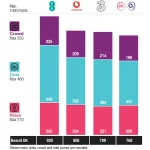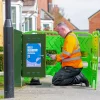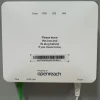Three UK Finally Adopt Carrier Aggregation to Boost 4G Speeds
Mobile operator Three UK has today announced that they’ve adopted the LTE-Advanced based Carrier Aggregation (CA) technology, which will enable them to combine several radio spectrum bands in order to boost 4G (Mobile Broadband) speeds for their customers. Sadly the initial coverage is limited.
CA technology has been around for quite a few years now. Indeed both EE and Vodafone have long been using it to produce significant improvements in their own 4G data speeds, such as by combining several blocks of radio spectrum in the 2.6GHz and 1800MHz bands per device (Smartphones etc.).
The absence of CA is one of the reasons why Three UK has struggled to keep pace with the speeds being delivered by their more established rivals (that and the fact that their users gobble 3.5 times more mobile data than the industry average). The good news is that they’ve finally begun to enable it, albeit only in “areas experiencing high growth in mobile internet demand.”
Advertisement
As usual the operator is being coy about their future roll-out plan, although initially over 2,700 sites across high-demand cities including London, Birmingham, Cardiff, Edinburgh and Glasgow can expect to benefit (look for the 4G+ sign to appear on your phone).
Dave Dyson, CEO of Three UK, said:
“Three customers are the highest consumers of data, with this trend expected to continue for several years. As we ready our network for 5G, we’re moving quickly to put the right technology in place to deliver the most reliable mobile experience for our customers. This latest innovation plays a critical role in ensuring our customers will be able to make the most of their mobile devices, both now and in the future.”
The operator estimates that around 50% of devices on their network can currently support CA technology and those users could see average mobile broadband speeds being boosted by between 15% and 33% (assuming you’re in an area that supports it). The more bands they can combine, the faster it tends to go.
Mark is a professional technology writer, IT consultant and computer engineer from Dorset (England), he also founded ISPreview in 1999 and enjoys analysing the latest telecoms and broadband developments. Find me on X (Twitter), Mastodon, Facebook, BlueSky, Threads.net and Linkedin.
« Vodafone UK Shaves £1 Off Superfast Home Broadband Prices


















































Comments are closed